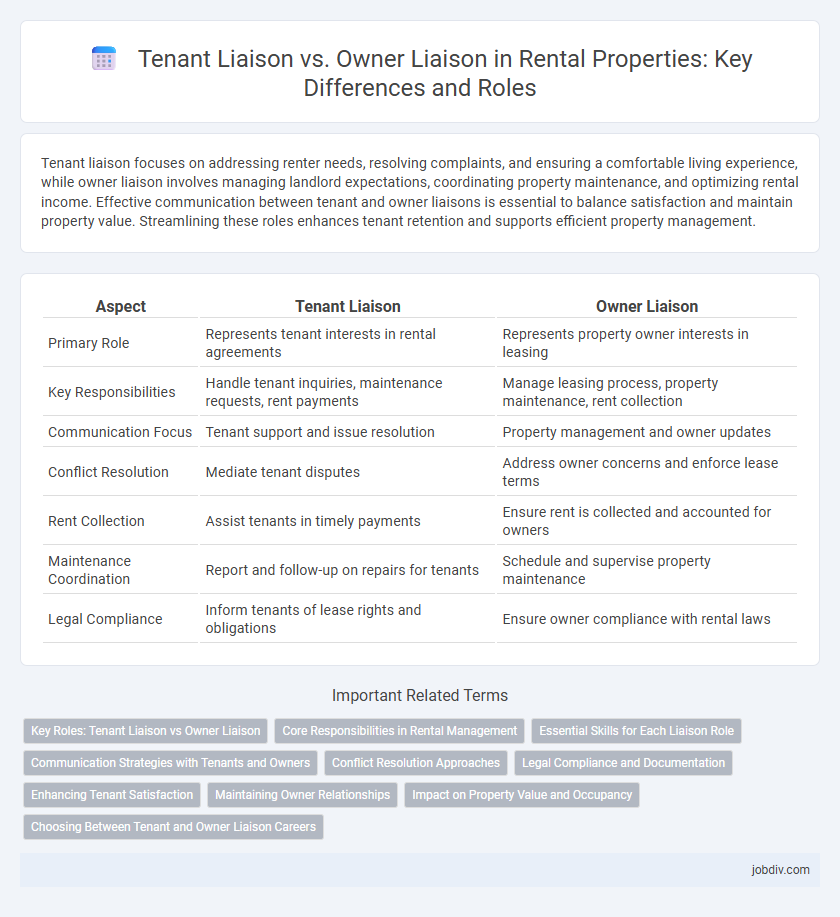Tenant liaison focuses on addressing renter needs, resolving complaints, and ensuring a comfortable living experience, while owner liaison involves managing landlord expectations, coordinating property maintenance, and optimizing rental income. Effective communication between tenant and owner liaisons is essential to balance satisfaction and maintain property value. Streamlining these roles enhances tenant retention and supports efficient property management.
Table of Comparison
| Aspect | Tenant Liaison | Owner Liaison |
|---|---|---|
| Primary Role | Represents tenant interests in rental agreements | Represents property owner interests in leasing |
| Key Responsibilities | Handle tenant inquiries, maintenance requests, rent payments | Manage leasing process, property maintenance, rent collection |
| Communication Focus | Tenant support and issue resolution | Property management and owner updates |
| Conflict Resolution | Mediate tenant disputes | Address owner concerns and enforce lease terms |
| Rent Collection | Assist tenants in timely payments | Ensure rent is collected and accounted for owners |
| Maintenance Coordination | Report and follow-up on repairs for tenants | Schedule and supervise property maintenance |
| Legal Compliance | Inform tenants of lease rights and obligations | Ensure owner compliance with rental laws |
Key Roles: Tenant Liaison vs Owner Liaison
Tenant liaisons manage communication, conflict resolution, and service requests between tenants and property management to ensure tenant satisfaction and retention. Owner liaisons oversee property performance updates, financial reporting, and strategic planning with property owners to maximize return on investment. Both roles require strong interpersonal skills but differ in focus: tenant liaisons prioritize day-to-day tenant experience, while owner liaisons concentrate on long-term property asset management.
Core Responsibilities in Rental Management
Tenant liaisons primarily focus on addressing tenant inquiries, managing lease agreements, coordinating maintenance requests, and ensuring tenant satisfaction for smooth occupancy. Owner liaisons handle communication with property owners, oversee financial reporting, rent collection, and ensure compliance with regulatory requirements. Both roles are essential for effective rental management, balancing tenant needs with owner interests to maintain property value and operational efficiency.
Essential Skills for Each Liaison Role
Tenant liaisons require strong communication, conflict resolution, and empathy skills to effectively address tenant concerns and maintain positive relationships. Owner liaisons need expertise in property management, financial acumen, and negotiation abilities to safeguard owner interests and optimize rental income. Both roles demand organizational skills and attention to detail to coordinate maintenance, lease agreements, and compliance with housing regulations.
Communication Strategies with Tenants and Owners
Tenant liaison prioritizes clear, consistent communication, using frequent updates and prompt responses to address tenant concerns and maintain satisfaction. Owner liaison focuses on transparent reporting and strategic dialogue to keep property owners informed about tenant issues, financial performance, and maintenance needs. Both roles utilize tailored communication channels to bridge expectations between tenants and property owners, enhancing operational efficiency and trust.
Conflict Resolution Approaches
Tenant liaisons prioritize understanding tenant concerns through consistent communication and mediation, aiming to resolve disputes amicably by addressing issues such as maintenance delays or lease misunderstandings. Owner liaisons focus on protecting property interests by enforcing lease terms and managing legal compliance, often employing formal notices or legal actions when conflicts escalate. Effective conflict resolution balances tenant satisfaction and owner rights, reducing vacancy rates and ensuring smooth rental operations.
Legal Compliance and Documentation
Tenant Liaison ensures legal compliance by managing rental agreements, verifying tenant eligibility, and addressing lease violations to protect tenant rights. Owner Liaison focuses on maintaining accurate property documentation, handling ownership rights, and ensuring landlord compliance with housing regulations. Clear communication and thorough record-keeping between both liaisons facilitate adherence to legal standards in property rentals.
Enhancing Tenant Satisfaction
Tenant liaison focuses on direct communication and support to address tenant concerns promptly, fostering a positive rental experience and boosting tenant satisfaction. Owner liaison manages property owner interests, ensuring maintenance and lease compliance align with owner expectations but impacts tenant satisfaction indirectly. Effective collaboration between tenant and owner liaisons streamlines issue resolution, creating a harmonious living environment that enhances overall tenant retention rates.
Maintaining Owner Relationships
Maintaining owner relationships requires clear communication and trust-building, where a tenant liaison focuses on addressing tenant needs and concerns to support property retention. Owner liaisons prioritize timely updates on property status, financial performance, and maintenance issues to align with owner expectations. Effective coordination between tenant and owner liaisons ensures seamless property management and long-term investment stability.
Impact on Property Value and Occupancy
Tenant liaison enhances property value by ensuring tenant satisfaction and reducing vacancy rates through effective communication and prompt issue resolution. Owner liaison contributes to strategic property management decisions that optimize financial performance and maintain asset value over time. Both roles are crucial for maximizing occupancy rates and sustaining long-term property appreciation.
Choosing Between Tenant and Owner Liaison Careers
Choosing between a tenant liaison and owner liaison career depends on your strengths in communication and conflict resolution; tenant liaisons specialize in managing tenant concerns, maintenance requests, and lease compliance, while owner liaisons focus on investor relations, property performance reporting, and strategic asset management. Tenant liaisons often handle day-to-day tenant interactions and foster community satisfaction, whereas owner liaisons act as the primary contact for property owners, ensuring transparency and alignment with investment goals. Career advancement in tenant liaison roles may lead to property management positions, while owner liaison experience can open pathways to real estate asset management and ownership advisory roles.
Tenant Liaison vs Owner Liaison Infographic

 jobdiv.com
jobdiv.com